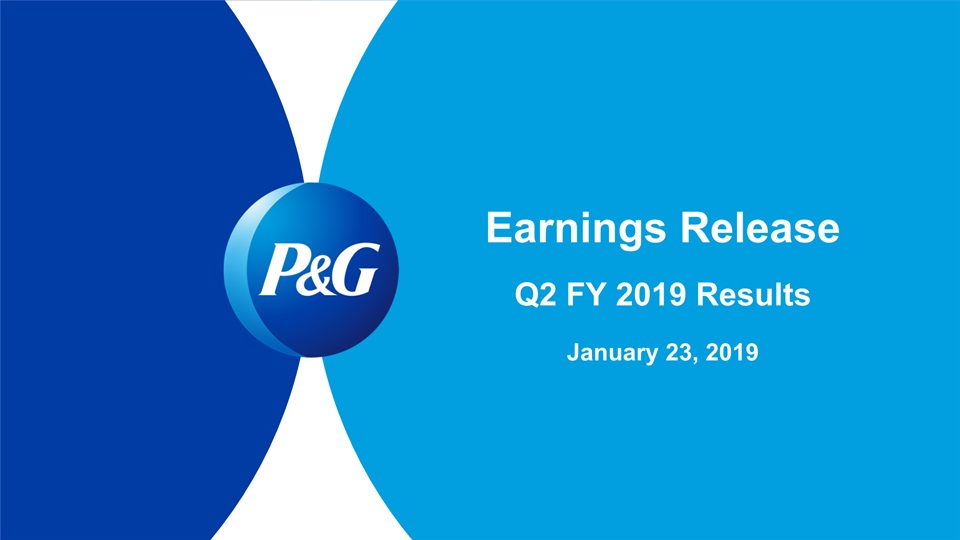Attached files
| file | filename |
|---|---|
| 8-K - OND Q2 FY19 EARNINGS - PROCTER & GAMBLE Co | ondq2fy19earnings.htm |
Earnings ReleaseQ2 FY 2019 ResultsJanuary 23, 2019

Business ResultsQ2 Fiscal Year 2019

Q2 Fiscal Year 2019 HIGHLIGHTS
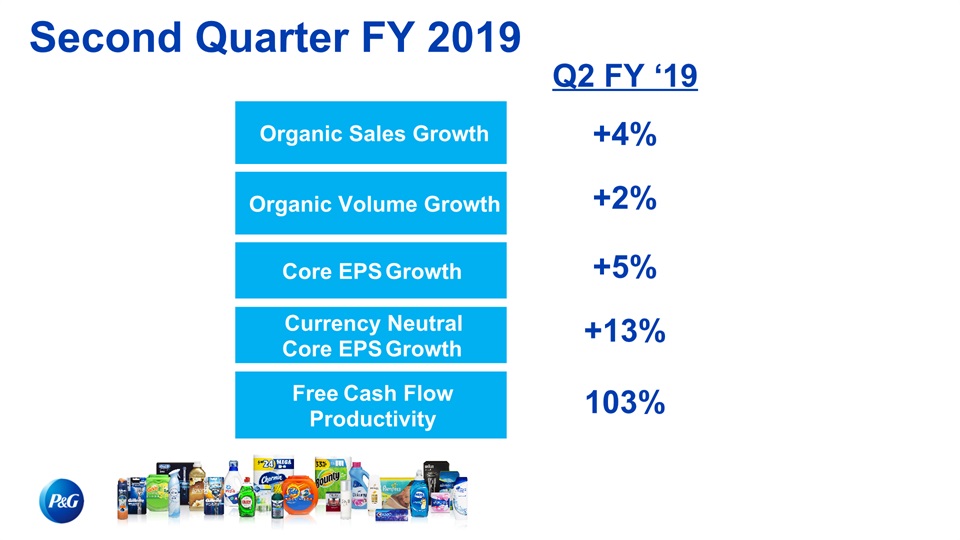
Second Quarter FY 2019 Organic Sales Growth Organic Volume Growth Core EPS Growth Free Cash Flow Productivity Q2 FY
‘19 +4% +2% +5% 103% Currency Neutral Core EPS Growth +13%
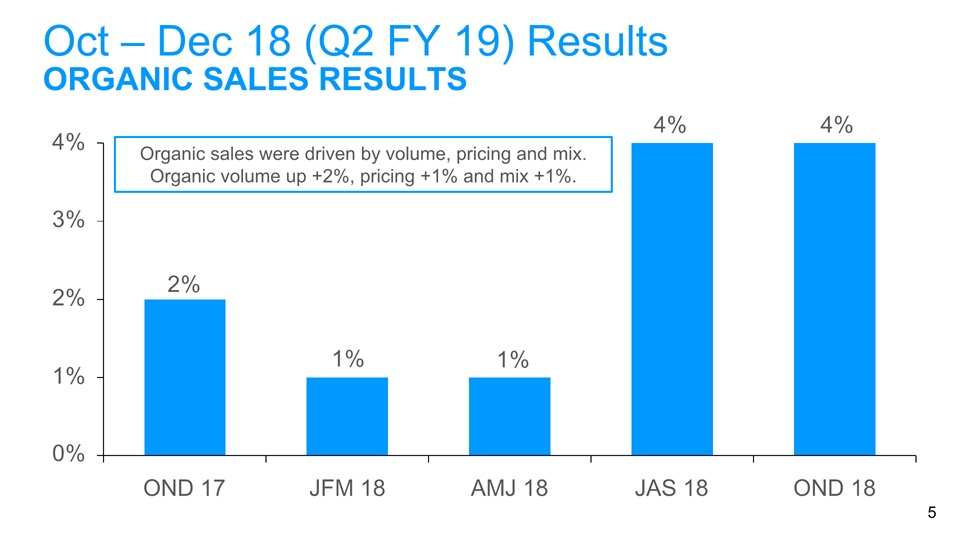
Oct – Dec 18 (Q2 FY 19) ResultsORGANIC SALES RESULTS Organic sales were driven by volume, pricing and mix. Organic volume up +2%,
pricing +1% and mix +1%.

Oct – Dec 18 (Q2 FY 19) ResultsCORE EPS GROWTH Core gross margin contracted 80 basis points, as 150 basis points (bps) of
productivity improvements and 50 bps of pricing help were more than offset by 90 bps of commodity cost increases, 60 bps of foreign exchange headwinds, 30 bps of innovation reinvestments and 100 bps of unfavorable product mix and other impacts.
Core operating margin decreased 10 basis points. Total productivity savings were 210 bps on the quarter.
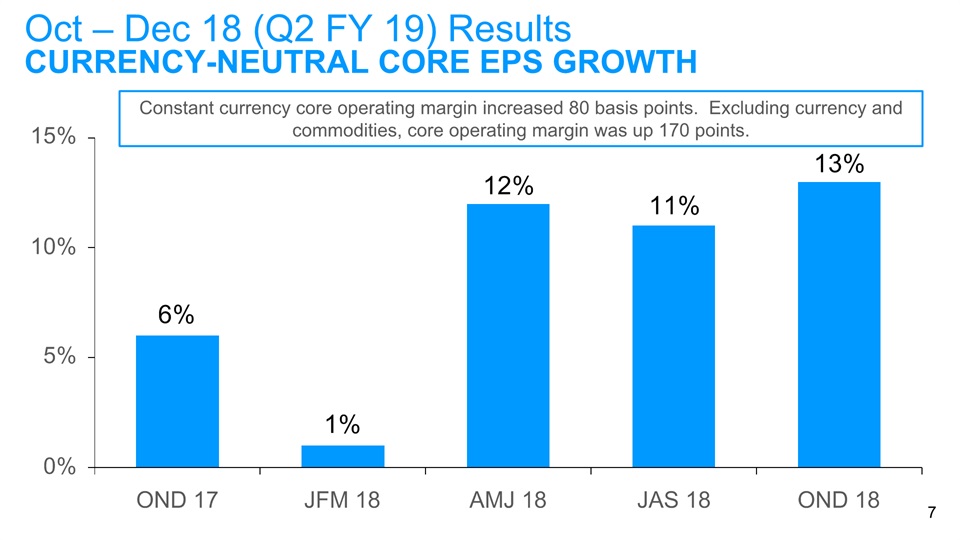
Oct – Dec 18 (Q2 FY 19) ResultsCURRENCY-NEUTRAL CORE EPS GROWTH Constant currency core operating margin increased 80 basis points.
Excluding currency and commodities, core operating margin was up 170 points.
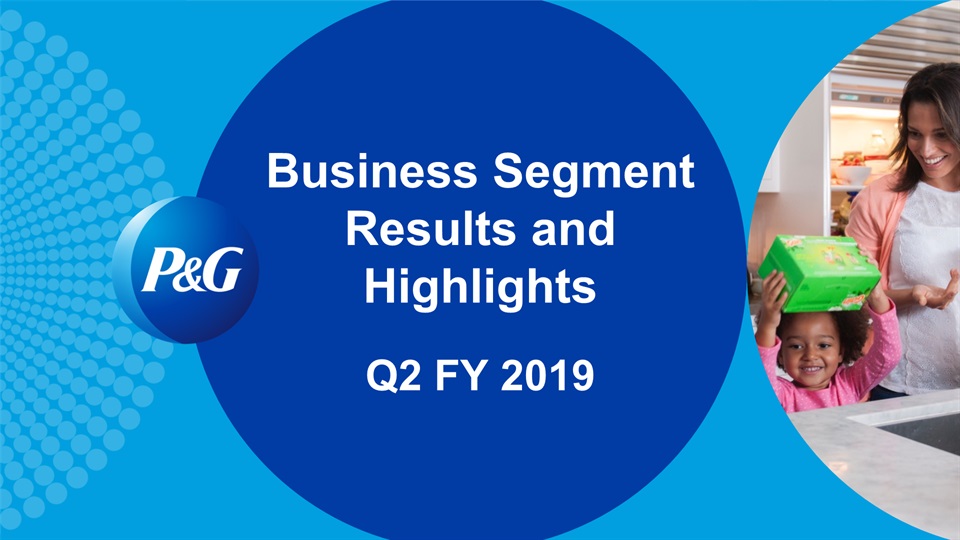
Business Segment Results and HighlightsQ2 FY 2019

+2% Pricing, +5% MixOrganic Sales: h Low single digits in Developed markets, h Double digits in Developing marketsGlobal value
share increased 0.1 points versus year agoNet Earnings: Favorable product mix, pricing, cost of goods sold savings and tax help were partially offset by currency headwinds. Oct – Dec 18 (Q2 FY 19) ResultsBEAUTY SEGMEN

Hair Care organic sales grew low single digits versus year ago. Developed markets were flat due to competitive activity. Developing
markets were up low single digits driven by premium innovation, devaluation pricing and strong retail execution.Skin & Personal Care organic sales grew double digits versus year ago. Skin Care sales grew double digits and Personal Care sales
grew low single digits. Developing markets were up double digits led by strong growth in China on both Olay Skin and SK-II. Developed markets were up mid-single digits led by double digit SK-II growth in Japan and premium product innovation in
Skin and Personal Care. By Category Organic Sales Growth IYA Global Developed Developing Hair Care + ~= + Skin & Personal Care + + + + represents growth above 1%, ~= represents growth of 1% to decline of 1%; - represents
decline greater than 1%. Oct – Dec 18 (Q2 FY 19) ResultsBEAUTY HIGHLIGHTS

* +1% Pricing, Flat Mix Organic Sa
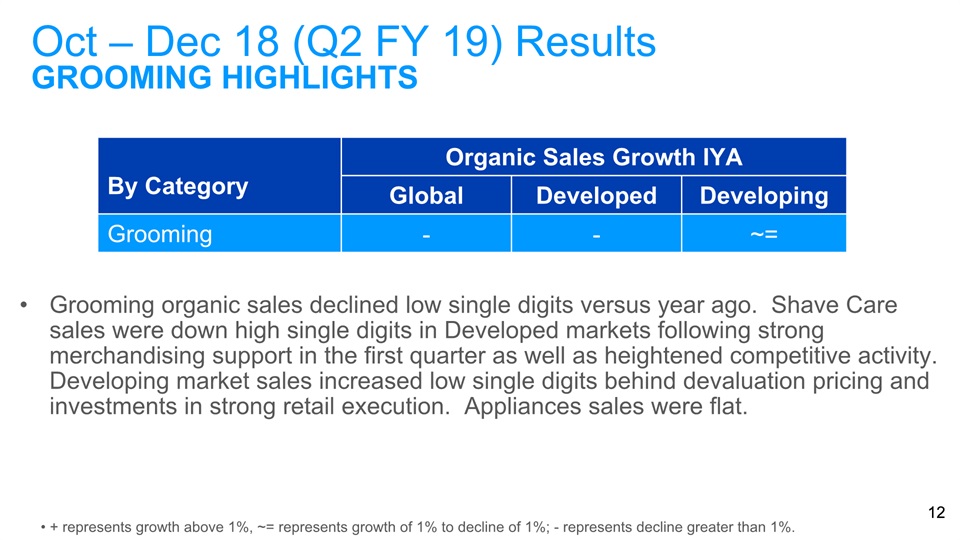
Grooming organic sales declined low single digits versus year ago. Shave Care sales were down high single digits in Developed markets
following strong merchandising support in the first quarter as well as heightened competitive activity. Developing market sales increased low single digits behind devaluation pricing and investments in strong retail execution. Appliances sales
were flat. By Category Organic Sales Growth IYA Global Developed Developing Grooming - - ~= Oct – Dec 18 (Q2 FY 19) ResultsGROOMING HIGHLIGHTS + represents growth above 1%, ~= represents growth of 1% to decline of 1%; -
represents decline greater than 1%.
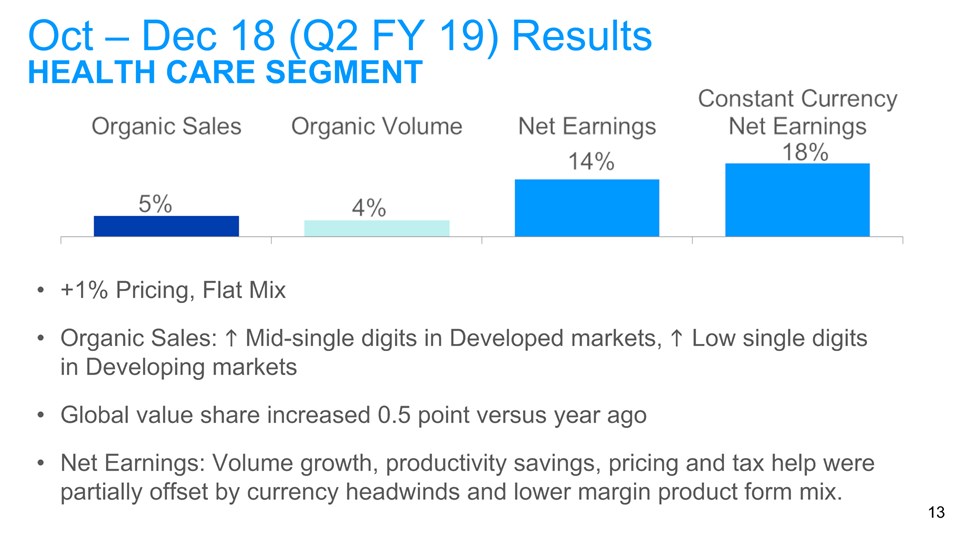
* +1% Pricing, Flat MixOrganic Sales: h Mid-single digits in Developed markets, h Low single digits in
Developing marketsGlobal value share increased 0.5 point versus year agoNet Earnings: Volume growth, productivity savings, pricing and tax help were partially offset by currency headwinds and lower margin product form mix. Oct – Dec 18 (Q2 FY
19) ResultsHEALTH CARE SEGMENT
+1% Pricing, Flat MixOrganic Sales: h Mid-single digits in Developed markets, h Low single digits in Developing marketsGlobal value
share increased 0.5 point versus year agoNet Earnings: Volume growth, productivity savings, pricing and tax help were partially offset by currency headwinds and lower margin product form mix. Oct – Dec 18 (Q2 FY 19) ResultsHEALTH CARE SEGMENT
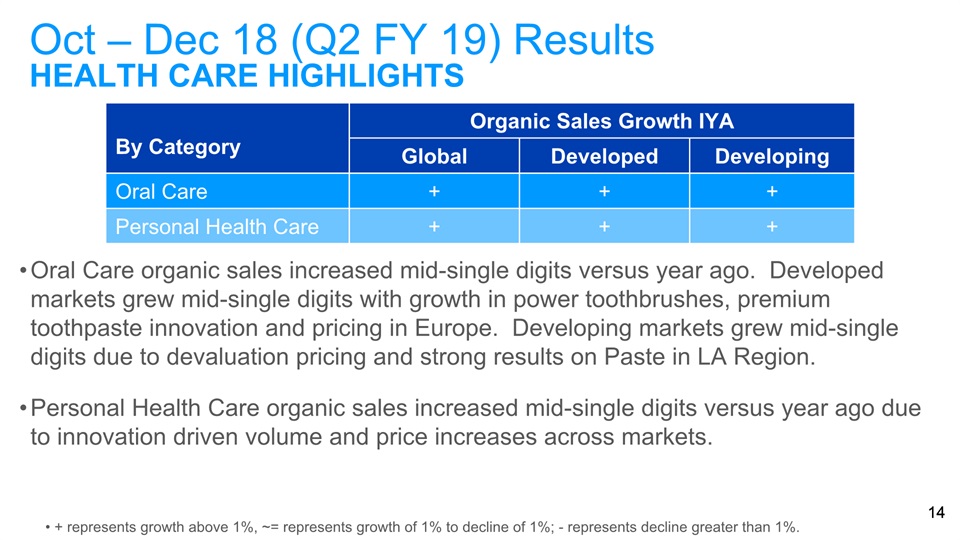
Oral Care organic sales increased mid-single digits versus year ago. Developed markets grew mid-single digits with growth in power
toothbrushes, premium toothpaste innovation and pricing in Europe. Developing markets grew mid-single digits due to devaluation pricing and strong results on Paste in LA Region.Personal Health Care organic sales increased mid-single digits versus
year ago due to innovation driven volume and price increases across markets. By Category Organic Sales Growth IYA Global Developed Developing Oral Care + + + Personal Health Care + + + + represents growth above 1%, ~=
represents growth of 1% to decline of 1%; - represents decline greater than 1%. Oct – Dec 18 (Q2 FY 19) ResultsHEALTH CARE HIGHLIGHTS
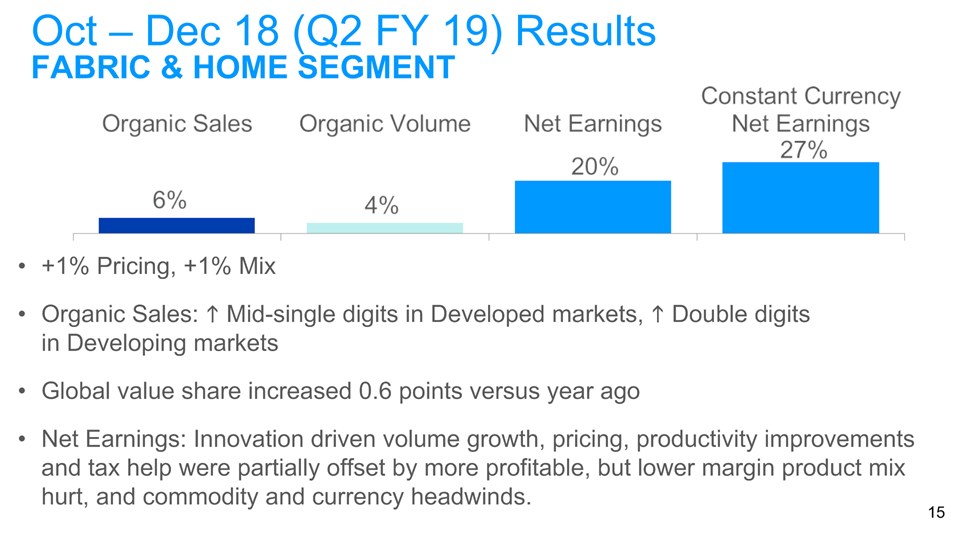
* +1% Pricing, +1% MixOrganic Sales: h Mid-single digits in Developed markets, h Double digits in
Developing marketsGlobal value share increased 0.6 points versus year agoNet Earnings: Innovation driven volume growth, pricing, productivity improvements and tax help were partially offset by more profitable, but lower margin product mix hurt,
and commodity and currency headwinds. Oct – Dec 18 (Q2 FY 19) ResultsFABRIC & HOME SEGMENT
+1% Pricing, +1% MixOrganic Sales: h Mid-single digits in Developed markets, h Double digits in Developing marketsGlobal value share
increased 0.6 points versus year agoNet Earnings: Innovation driven volume growth, pricing, productivity improvements and tax help were partially offset by more profitable, but lower margin product mix hurt, and commodity and currency headwinds.
Oct – Dec 18 (Q2 FY 19) ResultsFABRIC & HOME SEGMENT
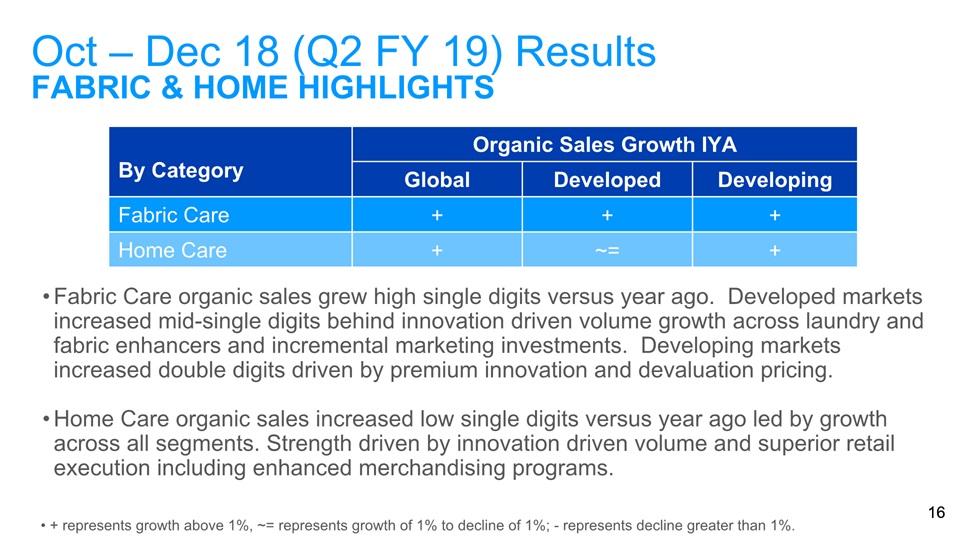
Fabric Care organic sales grew high single digits versus year ago. Developed markets increased mid-single digits behind innovation
driven volume growth across laundry and fabric enhancers and incremental marketing investments. Developing markets increased double digits driven by premium innovation and devaluation pricing.Home Care organic sales increased low single digits
versus year ago led by growth across all segments. Strength driven by innovation driven volume and superior retail execution including enhanced merchandising programs. + represents growth above 1%, ~= represents growth of 1% to decline of 1%; -
represents decline greater than 1%. By Category Organic Sales Growth IYA Global Developed Developing Fabric Care + + + Home Care + ~= + Oct – Dec 18 (Q2 FY 19) ResultsFABRIC & HOME HIGHLIGHTS
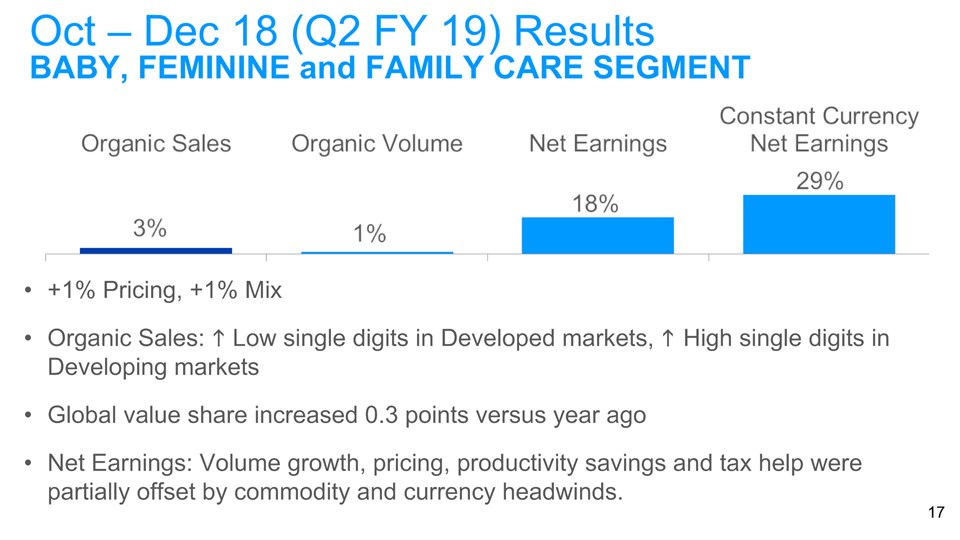
* +1% Pricing, +1% MixOrganic Sales: h Low single digits in Developed markets, h High single digits in
Developing marketsGlobal value share increased 0.3 points versus year agoNet Earnings: Volume growth, pricing, productivity savings and tax help were partially offset by commodity and currency headwinds. Oct – Dec 18 (Q2 FY 19) ResultsBABY,
FEMININE and FAMILY CARE SEGMENT
+1% Pricing, +1% MixOrganic Sales: h Low single digits in Developed markets, h High single digits in Developing marketsGlobal value
share increased 0.3 points versus year agoNet Earnings: Volume growth, pricing, productivity savings and tax help were partially offset by commodity and currency headwinds. Oct – Dec 18 (Q2 FY 19) ResultsBABY, FEMININE and FAMILY CARE SEGMENT
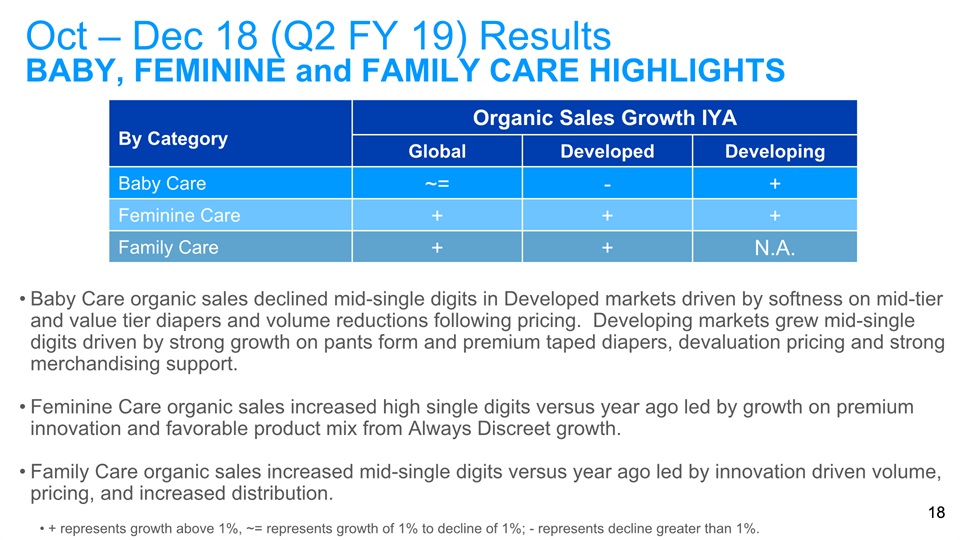
Baby Care organic sales declined mid-single digits in Developed markets driven by softness on mid-tier and value tier diapers and
volume reductions following pricing. Developing markets grew mid-single digits driven by strong growth on pants form and premium taped diapers, devaluation pricing and strong merchandising support.Feminine Care organic sales increased high single
digits versus year ago led by growth on premium innovation and favorable product mix from Always Discreet growth.Family Care organic sales increased mid-single digits versus year ago led by innovation driven volume, pricing, and increased
distribution. By Category Organic Sales Growth IYA Global Developed Developing Baby Care ~= - + Feminine Care + + + Family Care + + N.A. + represents growth above 1%, ~= represents growth of 1% to decline of 1%; -
represents decline greater than 1%. Oct – Dec 18 (Q2 FY 19) ResultsBABY, FEMININE and FAMILY CARE HIGHLIGHTS

FY 2019 Guidance
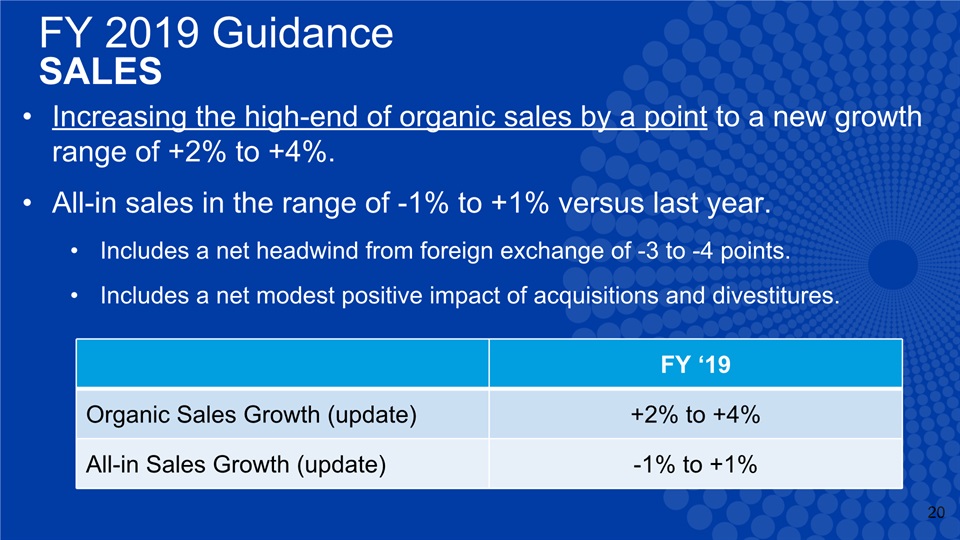
FY ‘19 Organic Sales Growth (update) +2% to +4% All-in Sales Growth (update) -1% to +1% Increasing the high-end of organic
sales by a point to a new growth range of +2% to +4%. All-in sales in the range of -1% to +1% versus last year.Includes a net headwind from foreign exchange of -3 to -4 points.Includes a net modest positive impact of acquisitions and
divestitures. FY 2019 GuidanceSALES

FY ‘19 Core EPS Growth +3% to +8% All-in EPS Growth +17% to +24% Core EPS growth of +3% to +8% (no change vs. prior
outlook)Expect net impact of interest expense, interest income and non-operating income to be a two point drag on EPS growthCore effective tax rate range of 19% to 20%~2% reduction on average diluted shares outstanding FY 2019 GuidanceCORE EPS
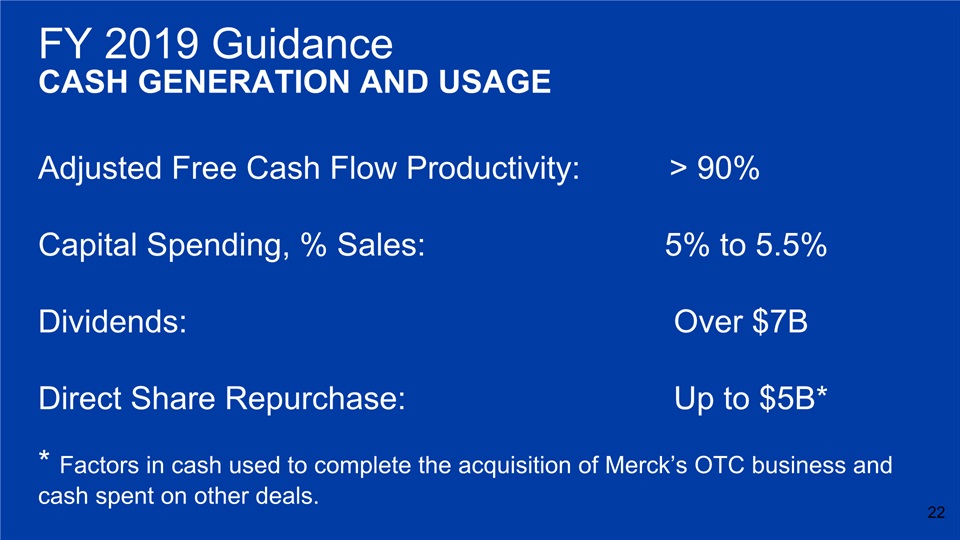
Adjusted Free Cash Flow Productivity: > 90%Capital Spending, % Sales: 5% to 5.5%Dividends: Over $7BDirect Share Repurchase: Up to
$5B** Factors in cash used to complete the acquisition of Merck’s OTC business and cash spent on other deals. FY 2019 GuidanceCASH GENERATION AND USAGE
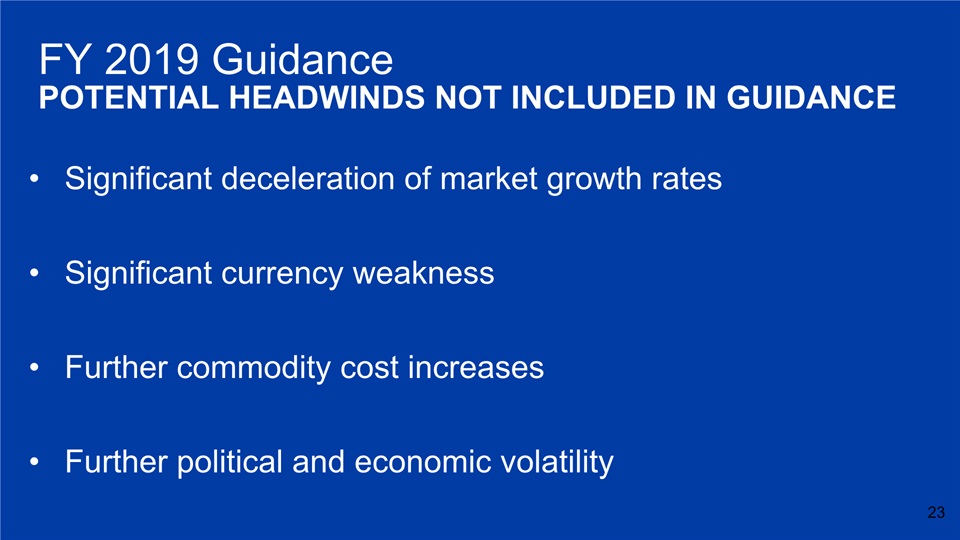
Significant deceleration of market growth ratesSignificant currency weaknessFurther commodity cost increasesFurther political and
economic volatility FY 2019 GuidancePOTENTIAL HEADWINDS NOT INCLUDED IN GUIDANCE
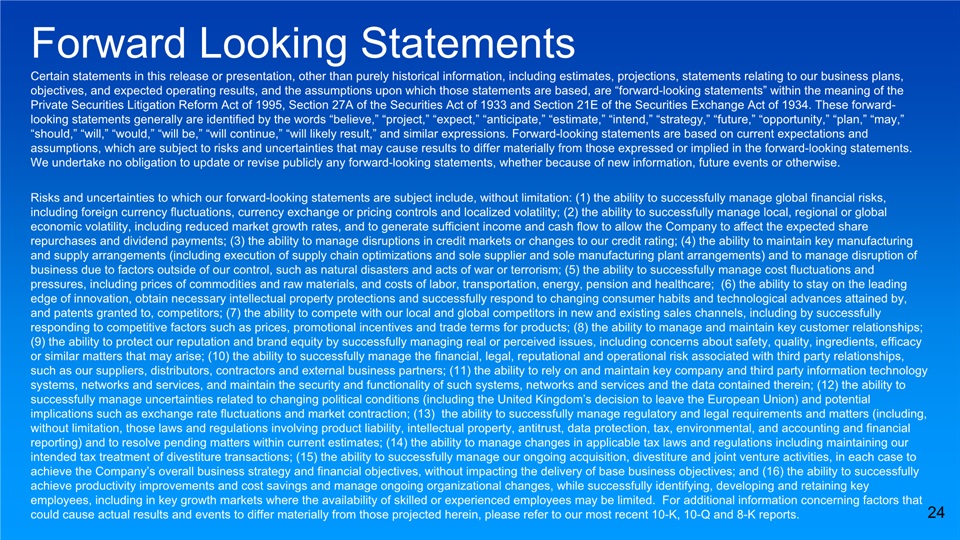
Forward Looking Statements Certain statements in this release or presentation, other than purely historical information, including
estimates, projections, statements relating to our business plans, objectives, and expected operating results, and the assumptions upon which those statements are based, are “forward-looking statements” within the meaning of the Private
Securities Litigation Reform Act of 1995, Section 27A of the Securities Act of 1933 and Section 21E of the Securities Exchange Act of 1934. These forward-looking statements generally are identified by the words “believe,” “project,” “expect,”
“anticipate,” “estimate,” “intend,” “strategy,” “future,” “opportunity,” “plan,” “may,” “should,” “will,” “would,” “will be,” “will continue,” “will likely result,” and similar expressions. Forward-looking statements are based on current
expectations and assumptions, which are subject to risks and uncertainties that may cause results to differ materially from those expressed or implied in the forward-looking statements. We undertake no obligation to update or revise publicly any
forward-looking statements, whether because of new information, future events or otherwise.Risks and uncertainties to which our forward-looking statements are subject include, without limitation: (1) the ability to successfully manage global
financial risks, including foreign currency fluctuations, currency exchange or pricing controls and localized volatility; (2) the ability to successfully manage local, regional or global economic volatility, including reduced market growth rates,
and to generate sufficient income and cash flow to allow the Company to affect the expected share repurchases and dividend payments; (3) the ability to manage disruptions in credit markets or changes to our credit rating; (4) the ability to
maintain key manufacturing and supply arrangements (including execution of supply chain optimizations and sole supplier and sole manufacturing plant arrangements) and to manage disruption of business due to factors outside of our control, such as
natural disasters and acts of war or terrorism; (5) the ability to successfully manage cost fluctuations and pressures, including prices of commodities and raw materials, and costs of labor, transportation, energy, pension and healthcare; (6)
the ability to stay on the leading edge of innovation, obtain necessary intellectual property protections and successfully respond to changing consumer habits and technological advances attained by, and patents granted to, competitors; (7) the
ability to compete with our local and global competitors in new and existing sales channels, including by successfully responding to competitive factors such as prices, promotional incentives and trade terms for products; (8) the ability to
manage and maintain key customer relationships; (9) the ability to protect our reputation and brand equity by successfully managing real or perceived issues, including concerns about safety, quality, ingredients, efficacy or similar matters that
may arise; (10) the ability to successfully manage the financial, legal, reputational and operational risk associated with third party relationships, such as our suppliers, distributors, contractors and external business partners; (11) the
ability to rely on and maintain key company and third party information technology systems, networks and services, and maintain the security and functionality of such systems, networks and services and the data contained therein; (12) the ability
to successfully manage uncertainties related to changing political conditions (including the United Kingdom’s decision to leave the European Union) and potential implications such as exchange rate fluctuations and market contraction; (13) the
ability to successfully manage regulatory and legal requirements and matters (including, without limitation, those laws and regulations involving product liability, intellectual property, antitrust, data protection, tax, environmental, and
accounting and financial reporting) and to resolve pending matters within current estimates; (14) the ability to manage changes in applicable tax laws and regulations including maintaining our intended tax treatment of divestiture transactions;
(15) the ability to successfully manage our ongoing acquisition, divestiture and joint venture activities, in each case to achieve the Company’s overall business strategy and financial objectives, without impacting the delivery of base business
objectives; and (16) the ability to successfully achieve productivity improvements and cost savings and manage ongoing organizational changes, while successfully identifying, developing and retaining key employees, including in key growth markets
where the availability of skilled or experienced employees may be limited. For additional information concerning factors that could cause actual results and events to differ materially from those projected herein, please refer to our most recent
10-K, 10-Q and 8-K reports.
The Procter & Gamble Company Regulation G Reconciliation of Non-GAAP Measures
In accordance with the SEC's Regulation G, the following provides definitions of the non-GAAP measures used in Procter & Gamble's January 23,
2019 earnings call, associated slides, and other materials and the reconciliation to the most closely related GAAP measure. We believe that these measures provide useful perspective on underlying business trends (i.e. trends excluding non-recurring
or unusual items) and results and provide a supplemental measure of year-on-year results. The non-GAAP measures described below are used by Management in making operating decisions, allocating financial resources and for business strategy purposes.
These measures may be useful to investors as they provide supplemental information about business performance and provide investors a view of our business results through the eyes of Management. Certain of these measures are also used to evaluate
senior management and are a factor in determining their at-risk compensation. These non-GAAP measures are not intended to be considered by the user in place of the related GAAP measure, but rather as supplemental information to our business results.
These non-GAAP measures may not be the same as similar measures used by other companies due to possible differences in method and in the items or events being adjusted.
The measures provided are as follows:
|
1.
|
Organic sales growth — page 3
|
|
2.
|
Core EPS and currency-neutral Core EPS — pages 4
|
|
3.
|
Core operating profit margin, constant currency Core operating profit margin, and Core operating profit margin excluding currency and
commodities — page 6
|
|
4.
|
Core gross margin — page 6
|
|
5.
|
Free cash flow — page 6
|
|
6.
|
Free cash flow productivity — page 6
|
|
7.
|
Adjusted free cash flow productivity – page 7
|
Organic sales growth*: Organic
sales growth is a non-GAAP measure of sales growth excluding the impacts of acquisitions and divestitures, the impact from the July 1, 2018 adoption of new accounting standards for “Revenue from Contracts with Customers”, the impact from India Goods
and Services Tax changes (which were effective on July 1, 2017) and foreign exchange from year-over-year comparisons. Management believes this measure provides investors with a supplemental understanding of underlying sales trends by providing sales
growth on a consistent basis.
The Core earnings measures included in the following reconciliation tables refer to the equivalent GAAP measures adjusted as
applicable for the following items:
|
•
|
Incremental restructuring: The Company has
had and continues to have an ongoing level of restructuring activities. Such activities have resulted in ongoing annual restructuring related charges of approximately $250 - $500 million before tax. In 2012 the Company began a $10 billion
strategic productivity and cost savings initiative that included incremental restructuring activities. In 2017, the Company communicated details of an additional multi-year productivity and cost savings plan. This results in incremental
restructuring charges to accelerate productivity efforts and cost savings. The adjustment to Core earnings includes only the restructuring costs above what we believe are the normal recurring level of restructuring costs.
|
|
•
|
Gain on Dissolution of the PGT Healthcare Partnership:
The Company finalized the dissolution of our PGT Healthcare partnership, a venture between the Company and Teva Pharmaceuticals Industries, Ltd (Teva) in the OTC consumer healthcare business, in the quarter ended September 30, 2018. The
transaction was accounted for as a sale of the Teva portion of the PGT business; the Company recognized an after-tax gain on the dissolution of $353 million.
|
|
•
|
Transitional Impact of U.S. Tax Reform: In
December 2017, the U.S. government enacted comprehensive tax legislation commonly referred to as the Tax Cuts and Jobs Act (the "U.S. Tax Act"). This resulted in a net charge of $628 million for the quarter ended December 31, 2017. The
adjustment to Core earnings only includes this transitional impact. It does not include the ongoing impacts of the lower U.S. statutory rate on current year earnings.
|
|
•
|
Early debt extinguishment charges: In fiscal
2018 and 2017, the Company recorded after-tax charges of $243 million and $345 million, respectively, due to the early extinguishment of certain long-term debt. These charges represent the difference between the reacquisition price and the
par value of the debt extinguished. Management does not view this charge as indicative of the Company’s operating performance or underlying business results.
|
We do not view the above items to be part of our sustainable results, and their exclusion from core earnings measures provides a more comparable
measure of year-on-year results. These items are also excluded when evaluating senior management in determining their at-risk compensation. Management views the following non-GAAP measures as useful supplemental measures of Company performance and
operating efficiency over time.
Core EPS and currency-neutral Core EPS*:
Core earnings per share, or Core EPS, is a measure of the Company's diluted net earnings per share from continuing operations adjusted as indicated. Currency-neutral Core EPS is a measure of the Company's Core EPS excluding the incremental current
year impact of foreign exchange.
Core operating profit margin*: Core
operating profit margin is a measure of the Company's operating margin adjusted for items as indicated.
Currency-neutral Core operating profit margin*:
Currency-neutral Core operating profit margin is a measure of the Company's Core operating profit margin excluding the incremental current year impact of foreign exchange.
Core operating profit margin excluding currency
and commodities: Core operating profit margin excluding currency and commodities is a measure of the Company's Core operating profit margin excluding the incremental current year impact of foreign exchange and commodities cost
increases.
Core gross margin: Core gross margin
is a measure of the Company's gross margin adjusted for items as indicated.
Free cash flow: Free cash flow is
defined as operating cash flow less capital spending. Free cash flow represents the cash that the Company is able to generate after taking into account planned maintenance and asset expansion. Management views free cash flow as an important measure
because it is one factor used in determining the amount of cash available for dividends, share repurchases, acquisitions and other discretionary investment.
Free cash flow productivity*: Free
cash flow productivity is defined as the ratio of free cash flow to net earnings. Management views free cash flow productivity as a useful measure to help investors understand P&G’s ability to generate cash. Free cash flow productivity is used by
management in making operating decisions, allocating financial resources and for budget planning purposes. The Company's long-term target is to generate annual free cash flow productivity at or above 90 percent.
Adjusted free cash flow productivity*:
Adjusted free cash flow productivity is defined as the ratio of adjusted free cash flow to net earnings adjusted for items as indicated. Management views adjusted free cash flow productivity as a useful measure to help investors understand P&G’s
ability to generate cash. Adjusted free cash flow productivity is used by management in making operating decisions, allocating financial resources and for budget planning purposes. The Company's long-term target is to generate annual free cash flow
productivity at or above 90 percent.
* Measure is used to evaluate senior management and is a factor in determining their at-risk compensation.
1. Organic sales growth:
|
Three Months Ended
December 31, 2018 |
Net Sales Growth
|
Foreign Exchange Impact
|
Acquisition &
Divestiture Impact/Other* |
Organic Sales Growth
|
|||
|
Beauty
|
4%
|
4%
|
0%
|
8%
|
|||
|
Grooming
|
(9)%
|
5%
|
1%
|
-3%
|
|||
|
Health Care
|
0%
|
3%
|
2%
|
5%
|
|||
|
Fabric Care & Home Care
|
2%
|
3%
|
1%
|
6%
|
|||
|
Baby, Feminine & Family Care
|
(1)%
|
4%
|
-%
|
3%
|
|||
|
Total P&G
|
-%
|
4%
|
-%
|
4%
|
* Acquisition & Divestiture Impact/Other includes the volume and mix impact of acquisitions and divestitures, the impact from the
July 1, 2018 adoption of new accounting standards for "Revenue from Contracts with Customers" and rounding impacts necessary to reconcile net sales to organic sales.
Organic Sales
Prior Periods
|
Total Company
|
Net Sales Growth
|
Foreign Exchange Impact
|
Acquisition/ Divestiture Impact*
|
Organic Sales Growth
|
|||
|
OND 2017
|
3%
|
(1)%
|
-%
|
2%
|
|||
|
JFM 2018
|
4%
|
(4)%
|
1%
|
1%
|
|||
|
AMJ 2018
|
3%
|
(2)%
|
-%
|
1%
|
|||
|
JAS 2018
|
-%
|
3%
|
1%
|
4%
|
* Acquisition & Divestiture Impact/Other includes the volume and mix impact of acquisitions and divestitures for all periods, the impact of India Goods and Services Tax implementation in FY 2018, the impact from the July 1, 2018 adoption of new accounting standards for "Revenue from Contracts with Customers" and rounding impacts necessary to reconcile net sales to organic sales.
Organic Sales
Guidance
|
Total Company
|
Net Sales Growth
|
Combined Foreign Exchange &
Acquisition/Divestiture Impact*
|
Organic Sales Growth
|
|||
|
FY 2019 (Estimate)
|
(-1)% to 1%
|
3%
|
+2% to +4%
|
* Acquisition & Divestiture Impact/Other includes the volume and mix impact of acquisitions and divestitures, the impact from the
July 1, 2018 adoption of new accounting standards for "Revenue from Contracts with Customers" and rounding impacts necessary to reconcile net sales to organic sales.
2. Core EPS and currency-neutral Core EPS:
|
Three Months Ended
December 31 |
|||
|
2018
|
2017
|
||
|
Diluted Net Earnings Per Share from Continuing Operations
|
$1.22
|
$0.93
|
|
|
Incremental Restructuring
|
0.03
|
0.02
|
|
|
Transitional Impacts of the US Tax Act
|
0.24
|
||
|
Core EPS
|
$1.25
|
$1.19
|
|
|
Percentage change vs. prior period
|
5%
|
||
|
Currency Impact to Earnings
|
0.09
|
||
|
Currency-Neutral Core EPS
|
$1.34
|
||
|
Percentage change vs. prior period Core EPS
|
13%
|
||
Note – All reconciling items are presented net of tax. Tax effects are calculated consistent with the nature of the underlying
transaction.
|
Six Months Ended
December 31 |
|||
|
2018
|
2017
|
||
|
Diluted Net Earnings Per Share from Continuing Operations
|
$2.44
|
$2.00
|
|
|
Incremental Restructuring
|
0.03
|
0.05
|
|
|
Transitional Impacts of the US Tax Act
|
-
|
0.23
|
|
|
Gain on Dissolution of PGT Partnership
|
(0.14)
|
||
|
Core EPS
|
$2.36
|
$2.28
|
|
|
Percentage change vs. prior period
|
4%
|
||
Note – All reconciling items are presented net of tax. Tax effects are calculated consistent with the nature of the underlying
transaction.
Core EPS
Guidance
|
Total Company
|
Diluted EPS Growth
|
Impact of Incremental
Non-Core Items*
|
Core EPS Growth
|
|
FY 2019 (Estimate)
|
+17% to +24%
|
(14)% to (16)%
|
+3% to +8%
|
* Includes the gain on the dissolution of the PGT Healthcare partnership in FY 2019 and the impact of U.S. Tax Act and loss on early extinguishment of debt in FY 2018 and year-over-year changes in incremental non-core restructuring charges.
Core EPS
Prior Quarters
|
OND 17
|
OND 16
|
JFM 18
|
JFM 17
|
AMJ 18
|
AMJ 17
|
JAS 18
|
JAS 17
|
|
|
Diluted Net Earnings Per Share from Continuing Operations, attributable to P&G
|
$ 0.93
|
$ 0.93
|
$ 0.95
|
$ 0.93
|
$ 0.72
|
$ 0.82
|
$ 1.22
|
$ 1.06
|
|
Incremental Restructuring
|
0.02
|
0.03
|
0.04
|
0.03
|
0.14
|
0.02
|
0.03
|
0.03
|
|
Early Debt Extinguishment Charges
|
-
|
0.13
|
-
|
-
|
0.09
|
-
|
-
|
-
|
|
Transitional Impact of U.S. Tax Act
|
0.24
|
-
|
0.01
|
(0.02)
|
-
|
-
|
||
|
Gain on Dissolution of PGT Partnership
|
-
|
-
|
-
|
-
|
-
|
-
|
(0.14)
|
-
|
|
Rounding
|
-
|
(0.01)
|
-
|
-
|
0.01
|
0.01
|
0.01
|
-
|
|
Core EPS
|
$ 1.19
|
$ 1.08
|
$ 1.00
|
$ 0.96
|
$ 0.94
|
$ 0.85
|
$ 1.12
|
$ 1.09
|
|
Percentage change vs. prior period
|
10%
|
4%
|
11%
|
3%
|
||||
|
Currency Impact to Earnings
|
(0.04)
|
(0.03)
|
0.01
|
0.09
|
||||
|
Currency-Neutral Core EPS
|
$ 1.15
|
$ 0.97
|
$ 0.95
|
$ 1.21
|
||||
|
Percentage change vs. prior period Core EPS
|
6%
|
1%
|
12%
|
11%
|
3. Core operating profit margin, constant currency core operating
profit margin, and core operating profit margin excluding currency and commodities:
|
Three Months Ended
December 31 |
||
|
2018
|
2017
|
|
|
Operating Profit Margin
|
22.3%
|
22.5%
|
|
Incremental Restructuring
|
0.5%
|
0.4%
|
|
Core Operating Profit Margin
|
22.8%
|
22.9%
|
|
Basis point change vs. prior year Core margin
|
(10)
|
|
|
Currency Impact to Margin
|
0.9%
|
|
|
Constant Currency Core Operating Profit Margin
|
23.7%
|
|
|
Basis point change vs. prior year Core margin
|
80
|
|
|
Commodity Impact to Margin
|
0.9%
|
|
|
Core Operating Profit Margin Excluding Currency and Commodities
|
24.6%
|
|
|
Basis point change vs prior year Core margin
|
170
|
|
4. Core gross margin
|
Three Months Ended
December 31 |
||
|
2018
|
2017
|
|
|
Gross Margin
|
48.9%
|
49.9%
|
|
Incremental Restructuring
|
0.7%
|
0.5%
|
|
Core Gross Margin
|
49.6%
|
50.4%
|
|
Basis point change vs. prior year Core margin
|
(80)
|
|
5. Free cash flow (dollar amounts in millions):
|
Three Months Ended December 31, 2018
|
||
|
Operating Cash Flow
|
Capital Spending
|
Free Cash Flow
|
|
$4,007
|
$(701)
|
$3,306
|
6. Free cash flow productivity (dollar amounts in millions):
|
Three Months Ended December 31, 2018
|
||||
|
Free Cash Flow
|
Net Earnings
|
Free Cash Flow Productivity
|
||
|
$3,306
|
$3,216
|
103%
|
||
7. Adjusted free cash flow productivity (dollar amounts in
millions):
Adjusted Free Cash Flow Productivity
Prior Periods
|
FY
|
Operating Cash Flow
|
Capital Spending
|
Adjustments*
|
Adjusted Free Cash Flow
|
Net Earnings
|
Adjustments**
|
Adjusted Net Earnings
|
Adjusted Free Cash Flow Productivity
|
|||||||||
|
2012
|
$13,284
|
$(3,964)
|
$519
|
$9,839
|
$10,904
|
$85
|
$10,989
|
90%
|
|||||||||
|
2013
|
$14,873
|
$(4,008)
|
-
|
$10,865
|
$11,402
|
$(333)
|
$11,069
|
98%
|
|||||||||
|
2014
|
$13,958
|
$(3,848)
|
-
|
$10,110
|
$11,785
|
-
|
$11,785
|
86%
|
|||||||||
|
2015
|
$14,608
|
$(3,736)
|
$729
|
$11,601
|
$7,144
|
$4,187
|
$11,331
|
102%
|
|||||||||
|
2016
|
$15,435
|
$(3,314)
|
-
|
$12,121
|
$10,604
|
$(72)
|
$10,532
|
115%
|
|||||||||
|
2017
|
$12,753
|
$(3,384)
|
$418
|
$9,787
|
$15,411
|
$(4,990)
|
$10,421
|
94%
|
|||||||||
|
2018
|
$14,867
|
$(3,717)
|
-
|
$11,150
|
$9,861
|
$845
|
$10,706
|
104%
|
|||||||||
| P7 Yrs |
$99,778 | $(25,971) | $1,666 | $75,473 | $77,111 | $(278) | $76,833 | 98% | |||||||||
* Adjustments for each year are as follows:
2012- tax payment for Snacks divestiture, 2015-tax payment for Pet Care divestiture, 2017- tax payment for Beauty Brands divestiture.
** Adjustments for each year are as follows:
2012- net of gain on Snacks divestiture and after-tax Braun impairment charge, 2013- net of gain on buyout of Iberian joint venture and Salon impairment charges, 2015- Batteries impairment and Venezuela deconsolidation charges , 2016- net of gain on
Battery business divestiture and Batteries impairment charge, 2017- net of loss on early debt extinguishment and gain on Beauty brands divesture, 2018- transitional impact of the U.S Tax Act and loss on early debt extinguishment.

